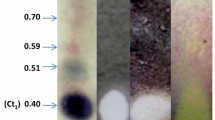This research work was aimed to assess the antioxidant, antimicrobial and enzyme inhibitory properties of fixed oil extracted from Tamarix aphylla stem bark. Fixed oil composition was assessed using gas chromatography–mass spectrometry (GC-MS) technique. The plant extract activity was assessed against various bacterial and fungal strains using hole diffusion and macro dilution techniques. Spectrophotometric method was used to measure the lipoxygenase and acetylcholinesterase inhibitory activities while antioxidant activity was assessed using ABTS radical scavenging and FRAP assay. Fixed oils were analyzed with the help of GC-MS, resulting in the identification of 03 compounds. Antibacterial assay showed that Staphylococcus aureus was the most affected bacterial strain with 7 mm zone of inhibition while among fungal strains, Candida glabrata was most significantly inhibited with 11 mm zone of inhibition. The tested samples were very efficient in its inhibitory activities against bacteria when 0.125, 0.5 and 1.0 mg/ml concentration was used. Similarly in case of fungi, 0.5, 1.0, 2.0 and 4.0 mg/ml of tested samples were showing significant results. Lipoxygenase and acetylcholinesterase inhibitory activities showed IC50 values of 90.1 μg/mL and 128.4 μg/mL, respectively. The antioxidant activity was assessed using ABTS radical scavenging and FRAP assays, and maximum inhibition of 87.01% was achieved at 800 μg/mL concentration. These results validate and endorse the centuries old folklore usage of T. aphylla as medicinal plant against various diseases.

Similar content being viewed by others
References
Z. A. El-Agbar, R. R. Naik, and A. K. Shakya, Orient. J. Chem., 34, 1368 (2018).
L. S. Nerio, J. Olivero-Verbel, and E. Stashenko, Biores. Technol., 101, 372 – 378 (2010).
A. R. Bilia, C. Guccione, B. Isacchi, et al., Evid. Based Complement. Altern. Med., 2014 (2014).
J. Asgarpanah and F. Ramezanloo, Afr. J. Pharm. Pharmacol., 6, 1573 – 1580 (2012).
R. Hänsel, Lipides, in: Pharmakognosie—Phytopharmazie, Springer (2007), pp. 739 – 808.
T. Schmeller and M. Wink, Utilization of alkaloids in modern medicine, in: Alkaloids, Springer (1998), pp. 435 – 459.
B. Liu, W. Li, Y. Chang, et al., J. Pharm. Biomed. Anal., 41, 1056 – 1060 (2006).
B. Pavlić, N. Teslić, G. Zengin, et al., Food Chem., 338, 127724 (2021).
T. M. Jasiem, N. M. Nasser, and H. K. AL-Bazaz, Res. J. Pharm. Technol., 12, 3219 – 3222 (2019).
A. S. Gadallah, S. Yousuf, A. Jabeen, et al., Molecules, 25, 2994 (2020).
R. Ullah, S. A. Tariq, N. Khan, et al., Asian Pac. J. Trop. Biomed., 7, 619 – 623 (2017).
M. Ali, H. A. Alhazmi, S. Ansari, et al., Tamarix aphylla (L.) Karst. Phytochemical and bioactive profile compilations of less discussed but effective naturally growing Saudi plant, in: Plant and Human Health, Vol. 3, Springer (2019), pp. 343 – 352.
A. Mahfoudhi, C. Grosso, R. F. Gonçalves, et al., Chem. Biodivers., 13, 1747 – 1755 (2016).
F. Rabbi, A. Zada, A. Adhikari, et al., Pharm. Chem. J., 54, 943 – 953 (2020).
L. B. Reller, M. Weinstein, J. H. Jorgensen, and M. Ferraro, Clin. Infect. Dis., 49, 1749 – 1755 (2009).
Z. Khan, In vitro and vivo screening techniques for bioactivity screening and evaluation, in: Proc. Int. Workshop UNIDO-CDRI (1997).
I. Khan, M. Nisar, N. Khan, et al., Fitoterapia, 81, 1020 – 1025 (2010).
I. F. Benzie and J. J. Strain, Anal. Biochem., 239, 70 – 76 (1996).
R. Re, N. Pellegrini, A. Proteggente, et al., Free Radic. Biol. Med., 26, 1231 – 1237 (1999).
A. Leaf and K. JX., J. Internal Med., 240, 5 – 12 (1996).
W. E. Connor, G. Weidner, S. L. Connor, and J. F. Hollis, Annals Inter. Med., 117, 820 – 823 (1992).
M. Neuringer, W. E. Connor, C. Van Petten, and L. Barstad, J. Clin. Invest., 73, 272 (1984).
V. Pawar and V. Thaker, Mycoses, 49, 316 – 323 (2006).
H. Shaheen, R. Qureshi, A. Akram, and M. Gulfraz, Arch. Sci., 65, 57 – 73 (2012).
S. M. Amini, Mater. Sci. Eng. C., 103, 109809 (2019).
G. Bergsson, J. Arnfinnsson, Ó. Steingrìmsson, and H. Thormar, Antimicrob. Agents Chemother., 45, 3209 – 3212 (2001).
A. Adebanjo, C. Adewumi, and E. Essien, Anti-infective agents of higher plants, in: International Symposium of Medium Plants, 5th ed., University of Ife, Nigeria (1983).
R. Wang and X. C. Tang, Neurosignals, 14, 71 – 82 (2005).
T. Ahmed, S. Zahid, A. Mahboob, and S. Mehpara Farhat, Curr. Neuropharmacol., 15, 480 – 494 (2017).
S. Guo, Z. Song, R. Ma, et al., Acta Physiol. Plant., 39, 111 (2017).
F. Rabbi, A. Zada, A. Nisar, et al., Pharm. Chem. J., 53, 1137 – 1144 (2020).
Conflict of Interest
The authors declare that they have no conflicts of interest.
Funding
This work was self-financed and was not funded by any funding agency.
Author information
Authors and Affiliations
Corresponding author
Rights and permissions
Springer Nature or its licensor (e.g. a society or other partner) holds exclusive rights to this article under a publishing agreement with the author(s) or other rightsholder(s); author self-archiving of the accepted manuscript version of this article is solely governed by the terms of such publishing agreement and applicable law.
About this article
Cite this article
Iqbal, A., Begum, N., Rabbi, F. et al. In-Vitro Antimicrobial, Antioxidant and Enzyme Inhibitory Activities of Fixed Oil Extracted from Stem Bark of Tamarix aphylla. Pharm Chem J 56, 1116–1122 (2022). https://doi.org/10.1007/s11094-022-02762-4
Received:
Published:
Issue Date:
DOI: https://doi.org/10.1007/s11094-022-02762-4



